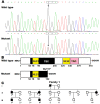A novel TBX5 mutation predisposes to familial cardiac septal defects and atrial fibrillation as well as bicuspid aortic valve
- PMID: 33306779
- PMCID: PMC7783509
- DOI: 10.1590/1678-4685-GMB-2020-0142
A novel TBX5 mutation predisposes to familial cardiac septal defects and atrial fibrillation as well as bicuspid aortic valve
Abstract
TBX5 has been linked to Holt-Oram syndrome, with congenital heart defect (CHD) and atrial fibrillation (AF) being two major cardiac phenotypes. However, the prevalence of a TBX5 variation in patients with CHD and AF remains obscure. In this research, by sequencing analysis of TBX5 in 178 index patients with both CHD and AF, a novel heterozygous variation, NM_000192.3: c.577G>T; p.(Gly193*), was identified in one index patient with CHD and AF as well as bicuspid aortic valve (BAV), with an allele frequency of approximately 0.28%. Genetic analysis of the proband's pedigree showed that the variation co-segregated with the diseases. The pathogenic variation was not detected in 292 unrelated healthy subjects. Functional analysis by using a dual-luciferase reporter assay system showed that the Gly193*-mutant TBX5 protein failed to transcriptionally activate its target genes MYH6 and NPPA. Moreover, the mutation nullified the synergistic transactivation between TBX5 and GATA4 as well as NKX2-5. Additionally, whole-exome sequencing analysis showed no other genes contributing to the diseases. This investigation firstly links a pathogenic variant in the TBX5 gene to familial CHD and AF as well as BAV, suggesting that CHD and AF as well as BAV share a common developmental basis in a subset of patients.
Conflict of interest statement
Figures



Similar articles
-
A New TBX5 Loss-of-Function Mutation Contributes to Congenital Heart Defect and Atrioventricular Block.Int Heart J. 2020 Jul 30;61(4):761-768. doi: 10.1536/ihj.19-650. Epub 2020 Jul 8. Int Heart J. 2020. PMID: 32641638
-
TBX5 loss-of-function mutation contributes to atrial fibrillation and atypical Holt-Oram syndrome.Mol Med Rep. 2016 May;13(5):4349-56. doi: 10.3892/mmr.2016.5043. Epub 2016 Mar 24. Mol Med Rep. 2016. PMID: 27035640 Clinical Trial.
-
ISL1 loss-of-function variation causes familial atrial fibrillation.Eur J Med Genet. 2020 Nov;63(11):104029. doi: 10.1016/j.ejmg.2020.104029. Epub 2020 Aug 6. Eur J Med Genet. 2020. PMID: 32771629
-
Congenital heart diseases and their association with the variant distribution features on susceptibility genes.Clin Genet. 2017 Mar;91(3):349-354. doi: 10.1111/cge.12835. Epub 2016 Sep 5. Clin Genet. 2017. PMID: 27426723 Review.
-
[BICUSPID AORTIC VALVE AND LEFT VENTRICULAR OUTFLOW TRACT DEFECTS IN CIIILDREN - SYNDROME OF BICUSPID AORTOPATHY?].Lijec Vjesn. 2015 Sep-Oct;137(9-10):267-75. Lijec Vjesn. 2015. PMID: 26749948 Review. Croatian.
Cited by
-
Nkx2.5: a crucial regulator of cardiac development, regeneration and diseases.Front Cardiovasc Med. 2023 Dec 6;10:1270951. doi: 10.3389/fcvm.2023.1270951. eCollection 2023. Front Cardiovasc Med. 2023. PMID: 38124890 Free PMC article. Review.
-
TBX5 variant with the novel phenotype of mixed‑type total anomalous pulmonary venous return in Holt‑Oram Syndrome and variable intrafamilial heart defects.Mol Med Rep. 2022 Jun;25(6):210. doi: 10.3892/mmr.2022.12726. Epub 2022 May 6. Mol Med Rep. 2022. PMID: 35514310 Free PMC article.
-
Update in Biomolecular and Genetic Bases of Bicuspid Aortopathy.Int J Mol Sci. 2021 May 27;22(11):5694. doi: 10.3390/ijms22115694. Int J Mol Sci. 2021. PMID: 34071740 Free PMC article. Review.
-
Comprehensive analysis of chloroplast genome of Albizia julibrissin Durazz. (Leguminosae sp.).Planta. 2021 Dec 23;255(1):26. doi: 10.1007/s00425-021-03812-z. Planta. 2021. PMID: 34940902
-
Chromosomal Location and Identification of TBX20 as a New Gene Responsible for Familial Bicuspid Aortic Valve.Diagnostics (Basel). 2025 Mar 1;15(5):600. doi: 10.3390/diagnostics15050600. Diagnostics (Basel). 2025. PMID: 40075846 Free PMC article.
References
-
- Abassi H, Gavotto A, Picot MC, Bertet H, Matecki S, Guillaumont S, Moniotte S, Auquier P, Moreau J, Amedro P. Impaired pulmonary function and its association with clinical outcomes, exercise capacity and quality of life in children with congenital heart disease. Int J Cardiol. 2019;285:86–92. - PubMed
-
- Al-Qattan MM, Abou Al-Shaar H. Molecular basis of the clinical features of Holt-Oram syndrome resulting from missense and extended protein mutations of the TBX5 gene as well as TBX5 intragenic duplications. Gene. 2015;560:129–136. - PubMed
-
- Alankarage D, Ip E, Szot JO, Munro J, Blue GM, Harrison K, Cuny H, Enriquez A, Troup M, Humphreys DT, et al. Identification of clinically actionable variants from genome sequencing of families with congenital heart disease. Genet Med. 2019;21:1111–1120. - PubMed
-
- Amedro P, Bajolle F, Bertet H, Cheurfi R, Lasne D, Nogue E, Auquier P, Picot MC, Bonnet D. Quality of life in children participating in a non-selective INR self-monitoring VKA-education programme. Arch Cardiovasc Dis. 2018;111:180–188. - PubMed
-
- Amedro P, Gavotto A, Legendre A, Lavastre K, Bredy C, De La Villeon G, Matecki S, Vandenberghe D, Ladeveze M, Bajolle F, et al. Impact of a centre and home-based cardiac rehabilitation program on the quality of life of teenagers and young adults with congenital heart disease: The QUALI-REHAB study rationale, design and methods. Int J Cardiol. 2019;283:112–118. - PubMed
Internet Resources
-
- The 1000 Genomes Project database. [May 6, 2020]. The 1000 Genomes Project database, http://www.1000genomes.org.
-
- The Genome Aggregation Database. [May 6, 2020]. The Genome Aggregation Database, https://gnomad.broadinstitute.org.
-
- The Single Nucleotide Polymorphism database. [May 6, 2020]. The Single Nucleotide Polymorphism database, http://www.ncbi.nlm.nih.gov/snp.
LinkOut - more resources
Full Text Sources

